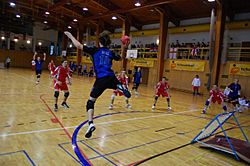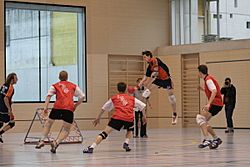Tchoukball facts for kids
Tchoukball is a super fun indoor team sport! It was invented in the 1970s by a Swiss biologist named Hermann Brandt. Dr. Brandt believed that sports should help people get along and build a friendly community, not just create champions. He wanted to create a game where players wouldn't get hurt often, unlike some other sports.
Contents
How to Play Tchoukball
The Court and Equipment
Tchoukball is usually played indoors on a court about 27 metres (89 ft) long and 16 metres (52 ft) wide. At each end of the court, you'll find a special 'frame'. This frame is like a small trampoline that the ball bounces off. It measures about 1 square metre (11 sq ft).
Around each frame, there's a D-shaped area marked on the floor. This area is called the 'D' or forbidden zone. It's a semicircular area with a radius of 3 metres (9.8 ft). Players are not allowed to step inside this 'D' zone.
Team Setup and Scoring
A Tchoukball game has two teams. Each team has 12 players, but only seven players from each team can be on the court at one time. What's cool about Tchoukball is that both teams can score points on either frame!
To score a point, an attacking player throws the ball at one of the frames. The ball must hit the frame and then bounce outside the 'D' zone. If the defending team can't catch the ball before it hits the ground, your team scores a point!
Important Game Rules
Tchoukball is known for being a very safe and friendly sport. Here are some key rules:
- No physical contact: Players are not allowed to touch or block opponents.
- No blocking passes: Defenders cannot try to stop the attacking team's passes.
- Moving with the ball: Players can take up to three steps while holding the ball.
- Holding the ball: You can only hold the ball for a maximum of three seconds.
- Passing limit: A team can pass the ball to each other up to three times before they must shoot at a frame.
These rules make the game fast-paced and focus on skill, teamwork, and strategy, rather than strength or tackling.
Tchoukball Around the World
Tchoukball has grown into a truly international sport! People play it in many countries across the globe. Some of these countries include Brazil, Canada, China, the Czech Republic, Great Britain, Hong Kong, India, Italy, Japan, Macau, Singapore, Switzerland, Taiwan, and the United States.
The sport is managed by the Féderation Internationale de Tchoukball (FITB). This organization was founded in 1971 and helps organize tournaments and promote the sport worldwide.
Major Competitions
Tchoukball has exciting international championships. For example, Taiwan hosted the World Championships in 2004. Taiwan's teams did great, winning both the women's and junior (younger players') championships! The men's championship that year was won by Switzerland.
More recently, the European Championships in 2006 were held in Switzerland. Great Britain showed strong performance, winning both the Men's and Under-18's titles. The Ladies' event was won by Switzerland. These tournaments bring together the best Tchoukball players from around the world!
Images for kids
See also
 In Spanish: Tchoukball para niños
In Spanish: Tchoukball para niños





